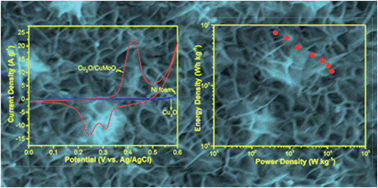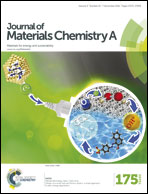Preparation of a hybrid Cu2O/CuMoO4 nanosheet electrode for high-performance asymmetric supercapacitors†
Abstract
Supercapacitors have attracted considerable attention due to their fast charge–discharge ability, excellent rate capability and long-term stability. In this study, a novel electrode composed of Cu2O/CuMoO4 nanosheets directly grown on Ni foam was synthesized via a facile hydrothermal method. The as-prepared electrode exhibits remarkably improved specific and areal capacitance (up to 4264 F g−1 and 9.38 F cm−2 at a current density of 1 A g−1). To the best of our knowledge, the specific capacitance of 4264 F g−1 is the highest in reported studies although the areal capacitance of 9.38 F g−1 is slightly lower than the highest value of 16 F cm−2 when Ni(OH)2/carbon nanotubes on Ni foam was used as the electrode. An asymmetric supercapacitor is fabricated using the Cu2O/CuMoO4 nanosheet electrode as the positive electrode and activated carbon (AC) as the negative electrode. The operation voltage could expand to 1.7 V, at which the energy density can reach 75.1 W h kg−1 with a power density of 420 W kg−1. Additionally, the asymmetric supercapacitor exhibits very high rate capability and good cycling stability. The capacitance remains around 86.6% after 3000 cycles at a current density of 5 A g−1. This indicates that the Cu2O/CuMoO4 nanosheet electrode is promising for applications in renewable energy storage in the future.



 Please wait while we load your content...
Please wait while we load your content...